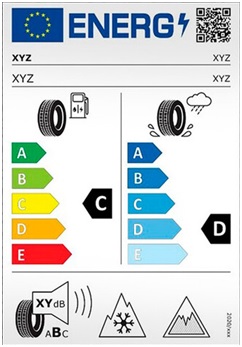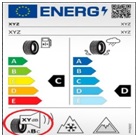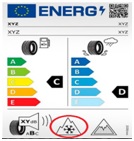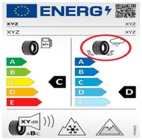For more details on the new EU tire labeling regulation, visita el sitio web oficial de la Comisión de la UE
EUROPEAN LABELING
In November 2012 the European Commission introduced the regulation on tire labeling to help consumers and companies make the best choice.
The regulation requires passenger car, SUV and light truck tires to have a label that provides clear information on fuel efficiency, wet grip and rolling noise.
The classifications are provided by the tire manufacturers themselves, according to the results of tests whose methods have been defined at a European level.
As of May 1, 2021, the European labeling is modified, mainly promoted by the European Union's climate and energy policy until 2030, which aims to reduce greenhouse gas emissions.

HOW TO READ THE NEW EUROPEAN TIRE LABELING?
BASIC TIRE INFORMATION
In this part appears the manufacturer's trade name or brand, the dimension designation, the manufacturer's reference (CAI), the identification of the type of tire in the regulatory sense (for example, C1 for passenger cars, C2 for vans and C3 for truck).
The new European labeling also incorporates a QR code in the upper right corner of the label.
By scanning the QR code of the label with a mobile application, you have access to the technical data sheet of the European Union EPREL database where the labeling of all products of all brands is registered.
NOISE LEVEL OF THE TIRES

EXTERNAL ENVIRONMENTAL NOISE FROM THE ROAD
It is rated in decibels (dB)
The previous 3 waves are now replaced by the letters: A,B or C (3 waves = C)
Traffic noise is noise pollution.
For a vehicle traveling at a constant speed of 80 km/h, the noise generated by the rolling of the tires on the road is generally higher than the noise of the engine itself.
This rolling noise depends on the type of tires and the road surface.

ICE GRIP SYMBOL

GRIP ON ICE
As the only point of contact with the road, the tire is essential to maintain safety on the ice found in the Nordic countries, for example.
This is the reason why the ice performance of the tires is now identified by this new “Ice Grip” pictogram (a triangle with a mountain inside), which certifies the efficiency in braking distance on ice.
1.4m at 20 km/h a car equipped with tires certified with the “Ice Grip” pictogram brakes in a distance of 1.4, shorter on ice than with all-season type tyres. Tires marked with the “Ice grip” symbol are specifically designed for driving on icy roads and packed snow, and should only be used in very severe winter conditions. The use of this type of tire in warmer weather conditions could alter its performance in terms of durability and grip.

3PMSF SYMBOL
Mountain with three peaks with a snowflake inside. Tires marked with the “3PMSF” pictogram are the only ones that guarantee true winter performance for use in snow as they comply with a specific certification test.(4)

ENERGY EFFICIENCY OF THE TIRE

1 FUEL TANK OUT OF 5 is consumed by the tires. When rolling a tire deforms when it comes into contact with the road. With deformations, the tire heats up and dissipates energy. The reduction of this accumulation of heat makes it possible to reduce fuel consumption, and consequently, CO2 emissions. The force that opposes the rotation of the tire is called “rolling resistance”.

WET ADHESION OF THE TIRE

1 MILLISECOND IS THE BRAKING DISTANCE ON WET GROUND
The tire is the vehicle's only point of contact with the road. At 80 km/h, it has less than 1 millisecond to respond to the driver's requests.
As an important component of the active safety of a vehicle, its mission is to adhere to the road, regardless of the condition of the ground (dry, wet, snow...), the layout of the road (straight or curved) or the weather conditions.

![]()
![]()
Fuente : Michelin

 Motorcycle tires
Motorcycle tires
 Car tires
Car tires
 BIB MOUSSE
BIB MOUSSE
 Accessories
Accessories
 Snow chains
Snow chains
 Outlet
Outlet